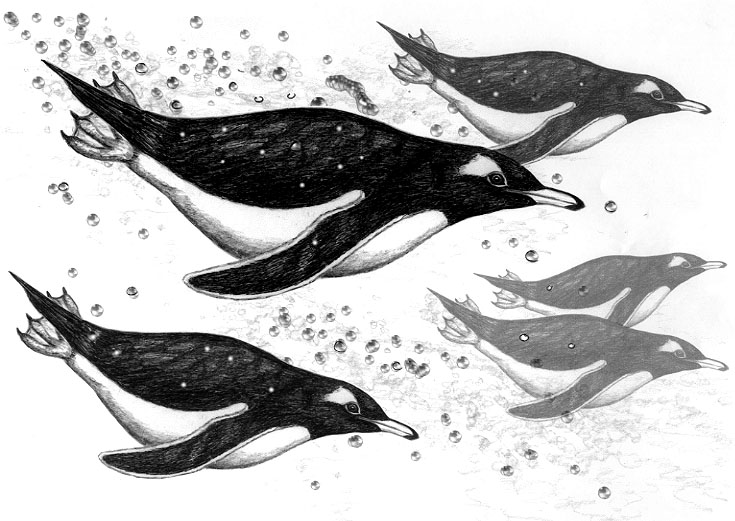
Dear Bird Folks,
I’d like to know why penguins can’t fly. They have wings, thus they should be able to fly. No?
– Brian, Anytown, USA
More importantly, Brian,
I’d like to know why you left something out. When asking a question, the universally accepted etiquette is to not only include your name, but also to provide us with the name of your town. I’m not exactly sure why the town thing is necessary, but I think it has to do with giving the question a touch of authenticity. This is known in the industry as the “Ann Landers Protocol” (I think). Since you neglected to include the name of your town, I had to give you one, or we would have been in violation of the A.L.P. I hope you don’t mind being from Anytown, USA. It’s actually not a bad place. In fact, a good friend of mine lives there. His name is John Doe. Perhaps you’ve heard of him.
Penguins are one of the most widely recognized birds in the world, yet most folks in North America have never seen one in the wild. The reason for the lack of penguin sightings is because they never venture north of the equator; they are strictly Southern Hemisphere birds. This simple fact seems to be lost on the greeting card people. They are forever showing penguins and Northern Hemisphere polar bears drinking hot chocolate, making snow angels, or having some of other lame interaction. It’s interesting to note that while penguins are not northern birds, they were named after one. The Great Auk, a flightless bird of the North Atlantic (which became extinct in 1852), was the very first bird to be called “penguin,” and it happened long before early explorers discovered “real” penguins. We don’t know why the Great Auks were called penguins, but one theory has to do with a derivation of “pin-wing,” a reference to the birds’ stubby wings. Sure. Why not? It makes sense.
While we are on the subject of polar bears, we all know that polar bears are white to help them blend in with their snowy surroundings. Penguins, on the other hand, which also like living in the snow, are black or at least half-black. I’m no camouflage expert, but it seems to me that a large, half-black bird standing in a mound of totally white snow, wouldn’t blend in very well. (Unless, of course, the mound of snow was one of those grimy snow piles we see in mall parking lots. Then half-black would blend in perfectly.) The reason why penguins have black backs is because they really aren’t snowbirds. They are seabirds and that’s where they want to be undetected. Their black backs allow hunting penguins to rise up from the depths of a dark ocean without being noticed by passing schools of fish.
In addition to their dark backs, penguins have several other adaptations that help them with their aquatic lifestyle. To begin with, their bones are different. Most birds have light, hollow bones, but penguins have solid bones. This gives them the extra weight needed for deep dives. Also, their bodies are streamlined, which helps them glide through the water like tiny torpedoes. Speaking extra weight, penguins have never been known for their hourglass figures. They have a layer of blubber to insulate them from the cold water. (An extra layer of blubber is something these birds have in common with many humans, especially after Thanksgiving.)
The one adaptation that sets penguins apart from all other birds is their wings. A fat, heavy bird with solid bones would require an enormous wingspan in order to fly. But large wings are a hindrance underwater. Many seabirds can only catch fish near the water’s surface, leaving a lot of yummy fish well out of their reach. Penguins decided years ago that there had to be a way to catch these fish, even if it meant giving up their ability to fly. Over the ages penguin wings have become smaller and more compact. These stubby wings are definitely not good for flying, but they make perfect paddles. Today penguins use their wings to “fly” underwater. Flipper-like wings, which look almost laughable on land, propel the birds effortlessly through some of the world’s harshest marine habitats.
It would seem that lack of flight would be a huge disadvantage to penguins, but for thousands of years this really wasn’t the case. Their food supply was all around them and since they nested on isolated islands, they were able to avoid most predators. Being flightless has worked out just fine for penguins…well, that is until you-know-who arrived. In recent centuries humans have killed penguins for food and for their skins and have collected untold numbers of their eggs. And whenever humans arrive their dreaded cats, dogs and rats are never far behind. Suddenly being flightless has become an issue. Unlike their avian cousins, penguins can’t take to air when terrestrial predators approach (and waddling away has never been an effective method of escaping danger). Penguins now find themselves at the mercy of humans…and that’s never a good thing.
Penguins can’t fly in the sky, Brian, but they can fly under water better than any of their airborne relatives. Speaking of relatives, give my best to the rest of your family in Anytown, USA. Also, keep your eyes open for my pal John Doe; he’s usually hanging out with his buddy, Joe Q. Public.